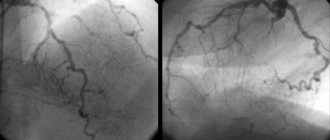Sign up
+7
Pericarditis is a heart disease manifested by an inflammatory process localized in the serous membrane of the organ. Acute pericarditis is an inflammatory syndrome with or without pericardial effusion (effusion). The diagnosis of subacute pericarditis is established when its duration is from 4-6 weeks to 3 months without remission. Recurrent pericarditis is diagnosed after a documented first episode of acute pericarditis and a symptom-free period of 4-6 weeks or longer (usually about 18-24 months).
Chronic pericarditis lasts longer than 3 months without remission. It can develop in various forms - asymptomatic, effusion, with lime deposits - the so-called “shell heart”, constrictive.
In whatever form the disease manifests itself - constrictive, effusion, etc. – it requires quick diagnosis and proper effective treatment.
Make an appointment with a specialist without queues, at a convenient time
Sign up
+7
Reasons for the development of the disease
This cardiac disease has a polyetiological nature:
- Infectious causes include rheumatic, tuberculous, bacterial. In addition, pericarditis can have a fungal or viral etiology, for example, with influenza.
- Aseptic reasons include allergies, diffuse connective tissue diseases, hematological diseases, malignant processes, injuries, radiation exposure, hypovitaminosis.
- Idiopathic pericarditis may also develop, the cause of which cannot be determined. It is these pathologies that are most often prone to relapse.
Prognosis and life with an armored heart
The prognosis is closely related to the cause of the pathology. With idiopathic pericarditis, patient survival is slightly better.
The prognosis improves after pericardiectomy, especially when performed at an early stage of the disease.
Poor prognosis factors:
- renal or liver failure;
- ascites;
- untreated ischemic heart disease;
- elderly age;
- heart failure class IV;
- radiation pericarditis;
- myocardial fibrosis.
In mild cases of the disease, the patient may not know about it and lead a normal life. Quality of life also improves after surgery. In other cases, the patient has increasing signs of heart failure, so he must limit salt and fluids, monitor his weight, without exposing himself to significant stress. If new symptoms, such as heart rhythm disturbances, appear, medical attention is needed.
We recommend reading about chronic myocarditis. You will learn about the causes of heart muscle pathology, symptoms, diagnosis, and treatment principles. And here is more information about atrial fibrillation.
Symptoms
Pain syndrome in acute pericarditis can be characterized by varying intensity. This can range from a slight tingling sensation when turning or bending sharply, to severe, all-consuming pain, like a heart attack. The pain may become stronger when sneezing, coughing, or deep breathing. There may be a sensation of radiating to the shoulder, neck, or shoulder blade.
In addition to pain, accompanying symptoms are: shortness of breath, mild headache or dizziness, and a slight increase in body temperature. Despite the fact that this symptomatology is quite “common,” it is extremely important to carry out a differential diagnosis and accurately determine the presence of pericarditis. Thus, acute pericarditis can be diagnosed if at least 2 of the following 4 signs are present:
- Pericardial chest pain.
- Pericardial murmur.
- The ECG interpretation shows signs of pericarditis.
- Pericardial effusion (formed or increased compared to the previous volume).
Additional signs: signs of an inflammatory process in the pericardium during imaging methods (computed tomography - CT, magnetic resonance imaging - MRI, ultrasound examination of the heart).
- Available: doctor’s appointment from 1500 rubles
- Convenient: open daily from 8:00 to 21:00
- Quickly: we will carry out all the diagnostics at the first appointment
- Complete: has all the necessary equipment
Physical examination
Upon external examination, attention is drawn to acrocyanosis (earlobes, nasolabial triangle, fingers acquire a bluish tint to the skin), which becomes more expressive in a horizontal position of the body; swelling of the neck veins, puffy face, enlarged abdomen due to fluid accumulation (ascites) and enlarged liver. As the disease progresses, the symptoms of circulatory failure progress. Shortness of breath becomes more pronounced, ascites increases.
Not only the liver, but also the spleen enlarges. “Pseudocirrhosis” develops, indicating the presence of liver failure. An increase in venous pressure leads to the fact that the neck and face become swollen, and the skin becomes bluish in color. This sign is called Stokes collar in medicine. Upon further examination, the borders of the heart are not enlarged, a pericardial friction murmur, a gallop rhythm are heard, heart sounds are muffled, the pulse is frequent and has weak filling.
Types of disease
The clinical picture and course of the disease depends on the underlying disease.
- Nonspecific pericarditis is often accompanied by frequent relapses. The most common cause of its occurrence is complications after viral infections or radiation. Occurs after a viral infection of the upper respiratory tract, insolation. Without timely treatment, it can develop into an exudative or constrictive form.
- With purulent pericarditis, hardware or puncture examination reveals a moderate accumulation of pus in the heart sac.
- Rheumatic pericarditis is a sign of active rheumatism and often occurs against the background of inflammation of the walls of the heart - rheumatic carditis.
- Metastatic pericarditis may be the first sign of lung or breast cancer. A primary pericardial tumor that also causes pericarditis, mesothelioma, is rare.
What are the types of pericarditis?
According to the pathophysiological mechanism, pericarditis is divided into:
- exudative pericarditis (when inflammatory fluid accumulates in the cavity - exudate);
- adhesive pericarditis (when “dry” inflammation predominates and adhesions form);
- constrictive pericarditis (when compression of the heart occurs and calcification of the pericardial walls).
This division is very arbitrary, because at different stages of the pathological process the type of inflammation can transform. And the formation of areas of calcification is the outcome of any pericarditis in the absence of adequate therapy.
Treatment
Most patients with acute pericarditis have a good long-term prognosis.
- Anti-inflammatory drugs.
- Immunosuppressive and biological therapy.
- Glucocorticoids.
- Diuretics - for large amounts of effusion.
Treatment will be different for pericarditis of different etiologies. Bacterial pericarditis is treated with antibiotics. If the pathology has a tumor cause, then cytostatics are used; uremic pericarditis requires hemodialysis. In difficult cases, surgery may be required to remove part of the pericardium.
Prices for services
| Name | Time | Price | |
| Appointment with a cardiologist, treatment and diagnostic, primary, outpatient | 1500 | ||
| Treatment and diagnostic appointment with a cardiologist, repeated, outpatient | 1000 | ||
| Preventive, outpatient appointment with a cardiologist | 550 | ||
| Holter ECG recorder with Holter data decoding | 3250 | ||
| Comprehensive consultation with a cardiologist ECG with interpretation + Echo-kg | 3650 | ||
| Call a doctor to your home (Khimki, Starbeevo, Ivakino, Naberezhnye) | 15000 | ||
| Calling a doctor to your home (Skhodnya, Podrezkovo, Novopodrezkovo, Planernaya station, Firsanovka) | 15000 | ||
| Call a doctor to your home (Kurkino, Novogorsk) | 15000 | ||
| Call a doctor to your home (Left Bank, Moscow, within the Moscow Ring Road) | 15000 | ||
| MRI of the thoracic spine. | 4500 | ||
| Medical consultation | 3300 | ||
| Extract from outpatient card | 660 | ||
| Consultation (interpretation) with analyzes from third parties | 1300 | ||
| Consultation on treatment adjustments | 550 | ||
| Repeated reception of CMN | 1600 | ||
| Initial reception of CMN | 2000 | ||
| Express test for determining the level of Troponin in the blood. | 1900 | ||
| Expand all prices | |||
General overview
The armored heart is often accompanied by the sweating of liquid volumes generated between the sheets of tissue. With this form of the disease, a person suffers from severe shortness of breath. The form is considered extremely dangerous, as it provokes purulent processes and can cause tamponade, that is, a condition when blood vessels and cardiac muscle tissue are compressed by volumes of accumulated fluid. When this form is detected, often the only treatment option is urgent surgery.
Armored heart is a disease associated with inflammatory processes caused by other health problems. Often, pericarditis indicates cardiac inflammation, an infectious agent, or systemic inflammatory processes. Pathology can develop when the functionality of an organ is impaired or as a consequence of injury.
Make an appointment with a cardiologist
If you need to get advice from an experienced cardiologist, call by phone in Moscow or fill out the form on our clinic’s website. You can undergo diagnostics directly at the clinic so that the doctor has the necessary data to make a diagnosis and develop an effective treatment regimen.
Remember that the lack of timely treatment of pericarditis can lead to serious complications - the formation of calcium-salt deposits in the heart, the development of heart failure, compression of the heart cavities and the inability of normal contractions.
Diagnostics
Other tests used for diagnosis include:
- a chest x-ray, which shows the shape of the heart and possible excess fluid;
- an electrocardiogram (ECG) to check your heart rhythm and see if the voltage signal is decreasing due to excess fluid;
- an echocardiogram, which will also show the shape, size of the heart and fluid accumulation;
- MRI;
- computed tomography, which provides a detailed image of the heart and pericardium;
- right heart catheterization, which will provide information about the pressure in the heart;
- blood tests to look for inflammatory markers that indicate pericarditis.
Secondary form
With this option, armored heart is treated with glucocorticoids. Correct use of the medication provokes resorption of the exudate. Therapy is most effective if the disease is caused by allergies or systemic pathology.
If exudate accumulates very quickly, cardiac puncture is required to prevent tamponade. The doctor removes the accumulated volumes. Sometimes such an event is required if the resorption process is too slow (half a month or more). By examining the puncture, specialists can more accurately determine the primary cause of pericarditis.
Curious moments
Despite the fact that armored heart is usually caused by various reasons, it is this disease that is often the most important for doctors, while other features of a person’s health condition are only secondary, since they are less dangerous. It is known that in about 6% of people with pericarditis, the disease was determined only posthumously. This pathology can occur at any age, although the risk group is adults and the elderly. Among the female half of the planet's population, the problem occurs with greater frequency than among the opposite sex.
Often, pericarditis affects the serous membrane of the main organ of our body. In such a situation, the serous form is diagnosed, and the tissues become permeable to blood, and the vessels through which it flows dilate. Leukocytes penetrate into nearby areas, fibrin is deposited, adhesions and scars form, and the pericardial sheets accumulate calcium. All this is accompanied by increased pressure on the heart and leads to a rather serious condition for the patient.
When is the danger greatest?
Armored heart is a disease provoked by a variety of factors, but doctors have identified several of them that significantly increase the likelihood of developing pathology. First of all, it is necessary to mention infections. Dangerous are measles, influenza, as well as various bacteria that can cause tonsillitis and scarlet fever, which accompany tuberculosis. Pericarditis is often observed due to blood poisoning, infection with parasites, and fungi. Inflammation can spread to the pericardium from nearby areas. This danger is associated with pneumonia, endocarditis, and pleurisy. The agent penetrates the pericardium through lymph or blood.
It is possible to detect an armored heart on an x-ray in case of an allergic reaction associated with medications, as well as in serum disease. The likelihood of such a pathology is higher in people suffering from heart disease, injuries to this organ, malignant neoplasms and metabolic problems. Particularly dangerous are toxic components, the production of which is associated with gout and uremia.
Continuing the topic
In some patients, pericarditis is fixed in a constructive form. With this progression, the leaves grow into fibrous tissues and become sites of calcium deposition. The lining of the heart becomes denser, and the chambers of the organ can only fill with blood to a limited extent. This leads to stagnation of fluid in the veins.
Often the chronic form develops according to the pearl oyster principle. This is most often associated with tuberculosis as the primary source of the inflammatory agent. Inflammatory granulomas spread throughout the serous cardiac membrane.
Where did the trouble come from?
Regarding the armored heart, the causes of the pathology are currently divided into two groups: infection and the aseptic path of development of the disease. Most often, the pathology is provoked by tuberculosis and rheumatism. In the first option, there are known cases of the movement of an infectious agent from the lungs through flows with lymph into different tissues of the body. This can cause damage to the heart lining. The disease is somewhat similar to allergies, but the process is infectious.
Rheumatism is the reason for the formation of an armored network of the heart, when two tissue layers are simultaneously affected: the myocardium and the endocardium.
Alternative Approach
If the disease is caused by a bacterial infection and a purulent form is detected, you should undergo a course of treatment with antimicrobial drugs. They select a specific program, having previously identified what the infection agents are sensitive to. If pericarditis is caused by tuberculosis, it is necessary to undergo six months of treatment (sometimes longer) with special anti-tuberculosis drugs. Usually several items are combined at once (up to three). If a tumor is detected, an urgent injection of a special medication directly into the pericardium is required.








